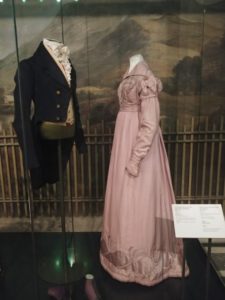We've all heard of Parliament--the House of Lords and the House of Commons. You'd think that the names of the two houses (roughly the equivalent of the US Senate/House), were fairly self-explanatory, but they're a bit of a misnomer.
The House of Lords (occasionally referred to as the House of Peers) is made of two parties - the Lords Spiritual and the Lords Temporal. The Lords Spiritual came from the Church of England and the Lords Temporal were both life peers and hereditary peers.
The House of Commons was comprised of both elected lords and commoners. Like the US House of Representatives, each borough (or district) had a set number of representatives to sit in Commons. By the early 1800s, many of the boroughs were no longer as populated or had even disappeared (one literally sunk), but still retained the same representation they had years before. Many of these boroughs sold their seat to the highest bidder, effectively giving those seats to one person, who then passed those seats to their cronies, or to the younger sons of lords.
By the late 1820s, early 1830s, the Whig party had managed to gain control of Commons, and attempted to pass a reform bill reorganizing representation to remove these "rotten" or "pocket" boroughs. The House of Lords (mostly from the Tory party) blocked this bill until King William threatened to create new peers and public riots broke out. The Representation of the People Act or the Reform Act finally passed in 1832.
This act not only removed representation from several of the older boroughs and gave representation to newer, larger boroughs (most notably in the industrial part of England), it also gave more people freedom to vote, including tradesmen and tenants-at-will.
Sources:
The Liberal Ascendancy, 1830-1886 by T.A. Jenkins
Party & Politics 1830-1852 by Robert Stewart
https://www.historyofparliamentonline.org/
https://en.wikipedia.org/wiki/Parliament_of_the_United_Kingdom
https://en.wikipedia.org/wiki/Reform_Act_1832
Friday, April 19, 2019
Wednesday, April 17, 2019
Bugs and Worms in Colonial Households

Housewives in Colonial America had to endure the same
challenges that modern families face, but their methods for dealing with vermin
were very different, indeed. There were no supermarkets stocked with traps and
repellent in those days, so homemade solutions were the only option.
Any parent can relate to the dread of a bedbug infestation.
So how did our ancestors tackle the problem? Homemakers would begin by
distilling wine and mixing the result with turpentine and dried henna. This
concoction would be spread around the entire room where an infestation is
suspected, including the lacing on the beds and the folds of the curtains. The
mixture, it is claimed, would not harm nor stain the finest silk or damask.
 Any home that has suffered the invasion of other crawling bugs
could be treated with a mixture of wormwood and mustard seed. A solution was
created by bruising the wormwood leaves and boiling the two ingredients in water
for fifteen minutes before adding salt.
Any home that has suffered the invasion of other crawling bugs
could be treated with a mixture of wormwood and mustard seed. A solution was
created by bruising the wormwood leaves and boiling the two ingredients in water
for fifteen minutes before adding salt.
House flies could be eliminated by steeping hellebore flower
in cow’s milk and sprinkling the liquid around the home.
The destruction of clothing from and moths and worms was
prevented by drying the herb botris and sprinkling the dust upon all garments.
But what if worms invade the children? A toxic mix of red
seaweed, mercuric sulfide, ground savine, and saffron was said to do the trick.
Sadly, the mixture was likely as damaging to the children as it was to the
worms.
Some of the information was adapted from The British jewel; or, Complete housewife's best companion, London, Printed and sold by J. Miller, 1769.
Wednesday, April 10, 2019
The Chrysanthemum Throne of Japan -- a Mythological Heritage
Emperor Kammu -- the son of a Korean Princess, Niigasa -- he felt a kinship with Koreans. He was also the first sovereign to marry a commoner -- Michiko Shoda -- breaking more than 2,600 years of tradition. During his reign (Heisei Era, 1989 to 2019), the nation enjoyed peace, but it was burdened by a period of economic stagnation -- "the Lost Decade" -- after the Japanese asset price bubble's collapse in later 1991; followed by the loss of more than 16,000 lives to the massive tsunami that flooded 200 square miles of coastal land in 2011.
Japan is a land of traditions and contradictions. It is where technology meets historical convention in perfect harmony; it is where shortcomings of nature (rugged terrains, mountains and forests cover 66% of its total territory) propelled the inhabitants to cultivate rice in terraced paddies, and volcanic spoils to be adapted into baths to produce health benefits. It is where the shrinking population and shortage of middle-class workers channelled investments into the robotic technology.
 |
| The mythological monster -- Yamata-no-Orochi |
Its imperial house, aka "Yamato Dynasty", is a royal clan who has been holding the sceptre of the throne for over twenty-six centuries, in an unbroken succession. These sovereigns (including Akihito and Naruhito) are allegedly, the offspring of Deities Izanami and Izanagi, who, according to the legend, created the islands (four main islands: Honshu, Shikoku, Kyushu and Hokkaido) and gave birth to the Kami (Gods), from whom its people are supposed to stem.
The Japanese first emperor is known as Jimmu, who upon defeating belligerent tribes and conquering the east islands, founded the country of Japan in year 660 BCE and self-proclaimed its emperor.
Along the years, his descendants survived treachery and rivalries by making alliances with powerful aristocratic families, but with the emergence of the samurai warrior class, the Yamato Sovereigns lost the grip to power and the Shogun assume the sway of the country in the early twelfth century. The emperors' role became merely symbolic and it would remain so for the next seven centuries.
Please visit my site to read more about the mythological beginning and historical narratives of Japan.
My book "The Goddesses of Japan" is the first novel of the series The Goddesses of the World. It is entirely narrated by unsung heroines, and spans the Creation of the country to its modernisation at the 19th century. It is sold at Amazon in ebook and paperback formats.
FaceBook: https://www.facebook.com/thegoddessesofjapan/
Website: https://thegoddessesofjapan.com/
Friday, April 5, 2019
The Vanity Helps of Times Past
When you check out at the supermarket or walk down the periodical section at your library or book store, you're bound to see magazines claiming all sort of wonderful things. This one promises you will lose those extra pounds, that one has 110 spring recipes, another claims to have a quiz that will help you decide if your man is right for you.
The modern consumer isn't the only one who was constantly bombarded with promises of life-changing articles and reads. There were etiquette books of all sorts written almost from the time that the printing press made books easier for people to grasp. My Middle Ages friends have even shown me illuminated manuscripts with (dubious) medical cures and household practices.
I've come across some great examples of this for the Georgian/Regency era lately. There is some incredible advice and examples in these old tomes.
For example, The Complete Art of Writing Love Letters: Or the Lover's Best Instructor. For just two shillings, one could own a copy of this book with several examples of different types of letters. You can read letters from complaining lovers, forlorn lovers, raving lovers, sincere lovers, and letters that read more like essays. All of them meant to guide men and women interested in pursuing romantic relationships.
The British Library site has more books, such as The New Lover's Instructor; Or Whole Art of Courtship: This one also contains a collection of fictional letters, dialogues, and so on all on the subject of love.
Letter-writing books and pamphlets were SUPER popular in the age when romantic love started gaining ground over arranged marriages. A properly written letter was considered something of an art form. Courtship had to be carried out in a particular manner lest the gentleman be considered a dunce or the woman too inexperienced to be worth the time to flirt.
Our predecessors were as concerned with doing things the right way as we are. Whether they read books on etiquette or doing the laundry properly, the people of the past may not have had our access to helpful magazines, but they had their own helps in their eras.
See also: How to Behave: A Pocket Manual of Etiquette and Guide to Correct Personal Habits
The Ladies' Book of Etiquette and manual of Politeness
Sally Britton is an author of Regency romance and her books can be found on Amazon.com
Thursday, April 4, 2019
Regency Fashions, the Walking Ensemble
 A fun aspect of reading and writing historical novels is the clothing. Who wouldn't want to dress up in a silk gown and dance or promenade, even if it's only vicariously? It's become one of my life's missions to seek out and sigh over any historical clothing while visiting museums. What started with a thirst for historical accuracy has morphed into a nerdy passion. This latest find is in the Victoria and Albert Museum in London. This photo to the left came from an exhibit circa 1815 to 1820--perfect for the Regency Era.
A fun aspect of reading and writing historical novels is the clothing. Who wouldn't want to dress up in a silk gown and dance or promenade, even if it's only vicariously? It's become one of my life's missions to seek out and sigh over any historical clothing while visiting museums. What started with a thirst for historical accuracy has morphed into a nerdy passion. This latest find is in the Victoria and Albert Museum in London. This photo to the left came from an exhibit circa 1815 to 1820--perfect for the Regency Era.This gentleman's ensemble would be appropriate for all informal daytime occasions. Any gentleman would look sophisticated and dashing in this cutaway tailcoat, waistcoat (which most people pronounce waist-coat but I'm told the truly posh way to pronounce it "wes-kit"), and expertly tied cravat. The bottom portion of his ensemble is not shown but a pair of knee breeches and tall boots would have been the most likely finishing touches.
 |
| Nankeen Half Boots |
The lady's ensemble is called walking dress or promenade dress. The garment itself is a lovely pelisse meant to protect the gown from the dirt of the streets as well as make a fashion statement. Notice the lovely detail on the bodice, sleeves and above the hemline. I love that dusty rose color!
The lady wearing this pelisse would have probably worn half boots which were sturdy enough for walking, cut short at the top for ease of movement, and still fashionable. Nankeen, a type of cotton, was a popular fabric to use for the upper portion of ladies walking books.
 |
| Hyde Park, February 2019 |
The couple wearing these clothes would have turned heads while walking or going for a carriage ride in Hyde Park.
Wednesday, April 3, 2019
The Ruin of a Lady by Jenna Jaxon
A lady in the Regency period (or Georgian or Victorian for that matter) had to guard her reputation stringently, for upon that rested not only her own status in Society but that of her family as well. In Pride and Prejudice, Lydia’s downfall by running off to London with Wickham is both a calamity in itself for her (reputation in shreds), but just as devastating for her sisters in terms of being received by those who knew of the scandal, but also in being able to find husbands willing to marry into the family. Not only was the offending woman ostracized by Society, but her relatives were assumed guilty just by being related to her.
A woman’s reputation could be lost through her own folly, as in the case of Lydia Bennett, or through no fault of her own.
To avoid societal ruin, a young lady must always be chaperoned either by an older female relative, a close male relative (immediate family only, as cousins were considered eligible partis), a companion, or a maid. If riding or driving in the park alone, a groom accompanied a young lady. Any woman who ignored these strictures, especially if she were caught alone with a gentleman (or God-forbid, kissing him except underneath he mistletoe), could end up with her reputation in shreds unless she married the gentleman in question.
Even ladies who became betrothed could lose their reputations if the gentleman had a change of mind and jilted her. Such an action, in the minds of Society, indicated that the gentleman had discovered some flaw in her character or that she had been intimate with another gentleman. So if a man broke the engagement, the woman in question would become all but unmarriageable, because it would be assumed that she was no longer pure. The prevailing custom in the Regency era for betrothed couples to “anticipate the wedding night” (engage in pre-marital sex) had a lot to do with this belief and in many cases would be true. The same unfortunate stigma would be attached to ladies whose betrothed died before they could be married.
The latter grave situation forms the conflict in my upcoming novella, Heart of Decadence, in which the heroine, Miss Amelia Burrowes’ betrothed died before they could marry. All indications point toward the suspicion that they had anticipated the wedding night and she had born a child after his death. Ten years later, Amelia’s parents have arranged a marriage to help repair her reputation (which was possible if given enough time and diligence), although she’s not thrilled with the mercenary gentleman. However, when she meets a long-lost love, she must convince him that a woman with a past deserves a future.
Heart of Decadence is now available for pre-order on Amazon in the boxed set Second Chance Love: A Regency Romance Set.
A woman’s reputation could be lost through her own folly, as in the case of Lydia Bennett, or through no fault of her own.
To avoid societal ruin, a young lady must always be chaperoned either by an older female relative, a close male relative (immediate family only, as cousins were considered eligible partis), a companion, or a maid. If riding or driving in the park alone, a groom accompanied a young lady. Any woman who ignored these strictures, especially if she were caught alone with a gentleman (or God-forbid, kissing him except underneath he mistletoe), could end up with her reputation in shreds unless she married the gentleman in question.
Even ladies who became betrothed could lose their reputations if the gentleman had a change of mind and jilted her. Such an action, in the minds of Society, indicated that the gentleman had discovered some flaw in her character or that she had been intimate with another gentleman. So if a man broke the engagement, the woman in question would become all but unmarriageable, because it would be assumed that she was no longer pure. The prevailing custom in the Regency era for betrothed couples to “anticipate the wedding night” (engage in pre-marital sex) had a lot to do with this belief and in many cases would be true. The same unfortunate stigma would be attached to ladies whose betrothed died before they could be married.
The latter grave situation forms the conflict in my upcoming novella, Heart of Decadence, in which the heroine, Miss Amelia Burrowes’ betrothed died before they could marry. All indications point toward the suspicion that they had anticipated the wedding night and she had born a child after his death. Ten years later, Amelia’s parents have arranged a marriage to help repair her reputation (which was possible if given enough time and diligence), although she’s not thrilled with the mercenary gentleman. However, when she meets a long-lost love, she must convince him that a woman with a past deserves a future.
Heart of Decadence is now available for pre-order on Amazon in the boxed set Second Chance Love: A Regency Romance Set.
Subscribe to:
Comments (Atom)










